Stretching exercise
Regular performing stretching exercises will improve the range of motion and help to relax the muscles. These effects can reduce the possibility of injuries like strains that affect muscles or tendons or sprains that affect ligaments.
Lower back pain and osteoarthritis are two chronic conditions for which stretching may offer pain relief. Flexibility is an essential part of wellness and general health. Everyday activities would be much more difficult without the capacity to bend over, twist, or squat. Your range of motion and flexibility will improve if you perform stretching as a daily part of your routine.
You can also get better at daily tasks and sports. Stretching may reduce the pain brought on by tense muscles and help avoid injuries. Try this quick workout routine to help you relax after work or to get ready for the hectic day ahead. It only takes five minutes.
Introduction:
One kind of physical exercise is stretching, which involves continuously flexing or stretching a particular muscle or tendon to increase muscle flexibility and achieve a comfortable tone. Improving muscle control, flexibility, and range of motion is the goal of stretching.
Although it might not be the most thrilling aspect of exercising, flexibility training is crucial to a comprehensive fitness program. Including some stretches in your workout routine will help you become more flexible, reduce tightness, and, in the end, increase the effectiveness and safety of your strength and cardio training.
During daily living activities, tense muscles can cause strain or injury to the nearby joints. Your muscles become less elastic and shorter as you get older. To preserve and lengthen our muscles and continue to be pain-free in our abilities, we must actively engage in this routine.
Stretching is unglamorous, and it’s unlikely to provide the same rush as a run or HIIT class. People prefer not to do this because it is uncomfortable and requires time. Strength training and cardio workouts independently won’t keep you secure from injury and pain. Your muscles will become imbalanced if you work out a lot, shortening your muscles, and never stretching them, lengthening them.
The body’s imbalances make certain muscles and joints overcompensate for other structures that are too tight to engage correctly, which raises the risk of injury. Strains and discomfort result from this. That is why stretching is so important, whether we are discussing leg, upper body, or back stretches. Stretching and flexibility exercises will help you more wherever your muscles are contracted.
Health Benefits of Stretching Exercise:
- Helps you play games more effectively.
- Reduces your chance of getting a joint injury.
- Assists in the full range of motion of your joints.
- enhances the blood flow to the muscles. Enhances the efficiency of your muscles’ movement.
- Help you improve your capacity to perform everyday tasks.
- Stretching can help with range of motion, flexibility, and posture, and yes, it can even be physically and psychologically calming.
- Stretching has a lot of benefits. Stretching boosts flexibility, which can enhance your range of motion both temporarily and permanently. This is important because, as you have previously self-reported, an improved range of motion can lead to improved muscle recruitment during your activities. For example, you can descend farther into a squat if your hips and knees are fully extended. In the end, having more range of motion will enable you to perform more exercises correctly.
- It’s about the little things in life that get harder as you age, like reaching down to tie your shoes, climbing stairs, picking up your child off the floor, or even just getting up from the couch, in my opinion. These daily tasks become easier when your mobility improves and you have greater freedom to move around.
- Pain, which can arise from tightness during exercise or spending hours bent over a desk, can be alleviated by stretching. Additionally, it can notify you of any muscle imbalances—for example, if you are performing one of your favorite hip flexor stretches and one side is tighter than the other.
When should you stretch?
The type of stretching that is done counts when talking about the best time to stretch. Stretching dynamically is a way to get your body ready for exercise. Movement-focused stretches such as the cat-camel, down dog to walking lunge, or threading the needle can be performed before an exercise session.
Static stretching, on the other hand, helps your body relax after a workout and speeds up the healing process when you hold a position. Static stretches at the end of your workout can help your mind decompress and mark the end of your workout. The moves below will concentrate on static stretches.
Stretching exercise is a very easy way to raise your range of movement and flexibility. All it takes is a little while. Before beginning a stretching regimen or foam rolling exercises, you might want to have a conversation with your physical therapist if you are having joint pain or discomfort, or if you are looking for specific exercises for pain relief or stretches for lumber pain. They can advise you on the precise moves that might be most beneficial for your particular situation.
Stretching ought to be done with consideration for pain. No pain should worsen either during or after the exercises. Before beginning any of these stretching exercises, please see your doctor for a complete evaluation and diagnosis.
Types of Stretching Exercise
There are various types and each offers a special benefit. Some standard types of stretching include:
Passive stretching
Your range of motion is unaffected by your relaxed state when using this technique. Rather, an external force is produced, either mechanically or by hand. Imagine your days of flexing over and reaching down to your toes in gym class.
A towel, resistance band, gravity, or a therapist are examples of external forces that can help to increase the stretch during this kind of stretching. After working out, people frequently do it to relax.
Static stretching
According to the Hospital for Special Surgery, static stretching involves extending a limb to produce a stretch sensation and then holding it there frequently for a few seconds. There is a slight distinction between static and passive stretching, even though they are frequently used synonymously.
Similar to passive stretching, static stretching involves holding a stretch, but unlike passive stretching, static stretching involves some sort of self-supporting hold. Similar to passive stretching, static stretching is frequently done for relaxation and right after a workout.
Active stretching
You perform this stretching on your own by moving a limb into a position that will allow you to stretch a muscle and then holding that position with your muscles. For example, you must raise one straight leg until your hamstrings stretch using your leg muscles while you are lying supine. Those who are recuperating from injuries may find this method beneficial as it facilitates mild strength training.
Isometric stretching
In addition to a static or active stretch, isometric stretching incorporates a static muscle contraction in which the muscle does not change length. The muscle you are stretching is being pushed against by something. A calf stretch is one example where you lunge forward with one foot, straighten your posterior leg by pressing down with your heel, and use your hands to press against a wall in front of you.
Generally, you do three to six repetitions of contracting the muscle for ten seconds and then stretching it for thirty seconds. Stretching like this can help people achieve rapid increases in flexibility because it increases the amount of signals sent by the nervous system to the muscles telling them to extend further.
Proprioceptive neuromuscular facilitation (PNF)
PNF is similar to isometric stretching, with the exception that the contract-relax method can be used for shorter durations fifteen seconds and a seven-second contraction than isometric stretching. In addition to stretching the targeted muscle, PNF stretching involves contracting the opposing muscle.
A hamstring stretch would therefore resemble this. As you lay on your back, have someone raise one leg towards the sky until the back of the raised leg stretches. Take a 15–30 second break there. Spend seven to fifteen seconds contracting the hamstrings, and then the quadriceps for the same amount of time. Stretch your hamstrings a little further while you’re at ease. Keep it in for 20 to 30 seconds. The duration of contractions is half that of stretches.
Dynamic stretching
By warming up before a workout and training your brain to get ready for action, you can make sure that your muscles are moving through their entire range of motion. You extend your muscles by moving them during dynamic stretching. Dynamic stretches include things like walking lunges, leg swings, and trunk twists.
Somatic stretching
Somatic stretching does not require holding a stretch for a long period, compared to other types of stretching. Muscle tension must be released with soft, organic movements that prioritize paying attention to how the muscles feel. For example, when you wake up, stretch and arch your back, or hang your head and notice the sensations that accompany it.
What kind of stretching should you do?
While there are many different kinds of stretching, you’ve undoubtedly heard of dynamic and static stretching.
The main aim of dynamic stretching is to use your joints and muscles through their entire range of motion (ROM), or as close to it as possible. When you sink into a position and hold it for a while, you are essentially static stretching. Ideally, you should feel some pushback, but not to the point of strain or pain.
Both are necessary for a well-rounded workout regimen, but the kind you select should ultimately be determined by the time you spend stretching.
You will frequently see dynamic stretching included in a warm-up because it’s an excellent way to get your muscles, tendons, and ligaments ready for exercise. Cat-cow, down dog to runner’s lunge, and thread the needle are a few stretches you can perform before working out. To prime and prepare your body and brain for the upcoming routine, it’s important to select dynamic stretches that resemble the movement patterns you’ll perform in real life.
On the other hand, static stretches are more effective when done as a final stretch; studies indicate that performing them right before a workout may decrease your strength, power, and explosiveness. Static stretches, on the other hand, can help your body and mind relax and your muscles loosen up if you close your routine with them. They are crucial even if you’re not working out because they can help you become more flexible and less prone to aches and pains in your muscles throughout the day.
We’re going to be concentrating on static stretching in this piece because mobility is so crucial both inside and outside the gym.
Why is stretching so important?
Stretching isn’t particularly glamorous, and you won’t likely feel the same rush that you would from a HIIT class or a run. However, it’s essential to your ability to advance in the gym and to generally feel better about yourself. Consider your exercise routine. According to a study, you are at the risk of suffering from pain and injury if you only focus on strength training or cardio and skip stretching.
Your muscles can become imbalanced if you spend a lot of time contracting (shortening) and never stretching (lengthening) them, she says. Strains, discomfort, and even injuries may result from some muscles and joints overcompensating for other joints that are too tight to move properly.
Stretching improves your muscles’ and tendons’ elasticity, or their capacity to expand. Because of this, it is crucial for enhancing mobility, or the capacity of a joint to move through its full range of motion (ROM). As previously reported by SELF, increased range of motion can result in improved muscle recruitment during strength training.
For example, you can go deeper into a squat if you have a greater range of motion in your hips and knees as well as flexibility in the surrounding muscles and tendons. In the end, being flexible and having a full range of motion can help you perform more exercises correctly and maximize their benefits.
Stretching has advantages outside of the gym. Regular static stretching can help reverse the effects of muscle shortening that results from spending too much time in one position, such as sitting, and relieve any associated stiffness and achiness. When you stand up from a long period of sitting, it can help release all the tight spots you feel in your front of the hips and hamstrings, for example, when you bend over to pick something up off the ground.
Improving your mobility and flexibility makes daily tasks easier, such as getting up from the couch, walking upstairs, picking up your child off the floor, and bending down to tie your shoes. These tasks become more difficult as one ages. You can move more freely.
Here we explain the different stretching exercises.
Trapezius stretch

- This stretch benefits every part of your upper limb, from your shoulders to your spine, by easing tension in your neck.
- Take a sitting position with your back straight and your chest raised, or you can stand with your feet shoulder-width apart and complete this stretch.
- To touch your right ear to your right shoulder, turn your head to the right.
- Apply a light pressure with your right hand to your head to increase the stretch.
- Hold for a duration of a minute to two minutes.

Triceps Stretch
- Raise your right elbow so that it points upward and raise it above your head.
- Pull the elbow behind the neck with the left hand while maintaining an upright posture and forward-facing trunk.
- For 30 seconds, hold on. Three times, repeat.
- Twice a day, practice two to three sets.
Triceps Stretch and Internal Rotation Stretch

- Place one arm behind the back, raise the other arm above the head so the elbow points upward, and raise the back as much as you can. For a greater stretch, curl your fingers and hold the fingers of the other hand if you can.
- Keep for thirty seconds. Repeat a minimum of three times.
- Every day, practice for two sets.

Shoulder and Triceps Stretch
- With the opposing arm, give the chest a firm grasp at shoulder height. with your trunk pointing frontward.
- Hold for a duration of 20 to 30 seconds. Repeat twice. Practice two or three sets twice a day.
Biceps and Anterior Capsule Stretch

- Standing and reaching both hands behind your back are required for this exercise. Close your fingers or make a fist if you can, then raise your arms higher behind your back.
- Keep for thirty seconds. Repeat three times. Practice three sets twice a day.
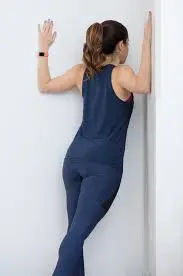
Bilateral Standing Pectoral and Bicep Stretch
- Place your forearms along the wall vertically while facing the corner wall and raise your arms to a 90-degree angle with your elbows bent. To enhance the stretch, bring your torso forward against a wall.
- Keep for thirty seconds. Do this twice over. Two times a day, practice three sets.

Unilateral Standing Pectoral and Biceps Stretch
- You must stand facing the wall and position your arm 90 degrees so that your palm is on the wall.
- To increase the stretch, turn your body, torso, and face towards the wall. For 30 seconds, hold. Do this three times. Twice a day, practice three sets.
Complete Upper Limb Stretch
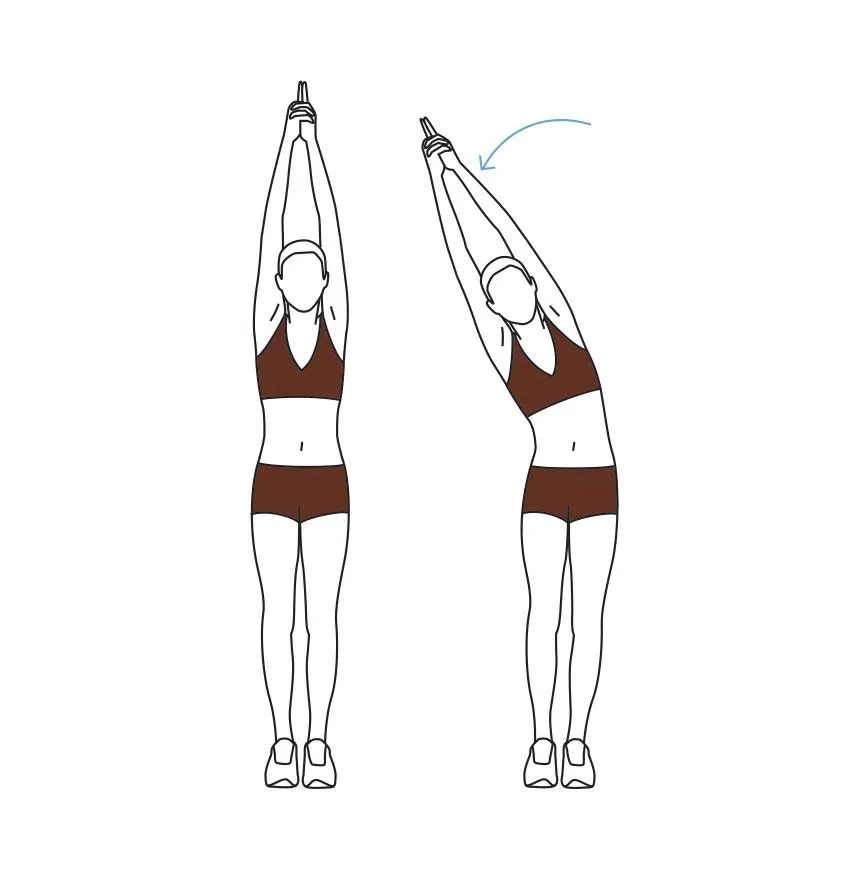
- Clasp hands together, rotate palms outward and raise arms straight above the head so that shoulders and ears are vertical.
- For 30 seconds, hold on. Three times, repeat.
- Twice a day, practice for three sets.
Upper Back and Posterior Shoulder Stretch
- Grab the shoulder blades with both hands by reaching around the body.
- To get a stretch, extend your fingers further around your back.
- For 30 seconds, hold.
- Do this three times. Practice twice a day for three sets.
Seated Shoulder Squeeze
- You enjoy this stretch because it helps to relieve tension in the upper back and correct bad posture.
- Take a sitting position with feet flat on the floor. Place a hand against the wall.
- As you extend and straighten your arms, firmly compress your shoulder blades together.
- Hold this pose for three seconds, then let go. Five to ten times is the repetition.

Wrist Flexor Stretch
- Utilize your additional hand to pull back your fingers and wrist whilst extending the elbow and taking the arm to ninety degrees in front of the body.
- Keep for 30 seconds. Replicate 3 times. Exercise 3 sets 2 times daily.
Wrist Extensor Stretch
- Raise an arm to ninety degrees in front of the body and use another hand to pull the fingers and wrist downward.
- Hold for 30 seconds. Repeat 2 to 3 times.
- Practice 3 sets two times daily
Gate Pose
- You must kneel and then extend your left leg to the side, pointing your toes either forward or to the right, to perform the gate pose.
- Turned around and walked your right hand down your leg.
- Raise and extend your left hand straight to the right side.
- Straight through your left fingertips and move your left ribs up toward the sky.
- Hold this position for seconds.
- Repeat this on both sides.
Cobra Pose
- Stretching the transverse abdominis muscle is known as Cobra Pose (Bhujangasana).
- This pose helps to open up your hips and gently extends your abdominal muscles.
- To do this stretch you have to lie with your face facing downward on the ground or an exercise mat.
- This is your starting position. Gaze straight ahead and raise your upper limb while keeping your hips flat on the floor.
- This will stretch the abdominal muscles.
- Take a twenty-second break from this stance and then go back to the starting position.
Stand and Bend
- Standing and bending help to stretch the muscles that run along your spine and your anterior abdominal wall in addition to your oblique muscles.
- Begin this stretch by standing with your feet shoulder-width apart and both feet parallel.
- To do this stretch you have to do an Intertwine your fingers and extend your arms overhead, turning your palms up toward the sky.
- Inhale through your nose and engage your abdominals and glutes.
- Exhale and bend to the right. Throughout the exercise, keep your hips steady.
- After 40 seconds of holding it, go back to the starting position.
- Repeat this stretch on both sides.
Basic Standing Stretch
- This is a Rectus abdominis stretching exercise.
- The standing abdominal stretch is the most fundamental exercise for the rectus abdominis.
- To start this stretching exercise take a Standing position with your feet together and raise your arms over your head.
- Open up your chest as you flexed your back. As you move your arms behind your head, they should be extended towards the sky.
- After maintaining this position for twenty seconds, take a thirty-second break and repeat the stretch two more times.
Cat cow pose
- You must come onto all four limbs in position for this stretch, and you must arch your back and draw your head downward like a cat.
- Gaze upwards to extend the muscles in your neck, then fully descend to extend the muscles in your abdomen.
- Hold this cat and cow stretch for 30 to 40 seconds, then back to the quadruped position.
- Repeat 3- 4 times.
Standing Hamstring Stretch

- Place yourself in a standing position with your arms by your sides, knees slightly bent, and feet hip-width apart.
- Exhale as your head, neck, and shoulders remain relaxed as you bend forward at the hips and lower your head toward the ground.
- Wrap your arms around the backs of your legs and hold anywhere from 30 seconds to 3 minutes.
- Flex your knees and roll up when you are done.
Piriformis Stretch
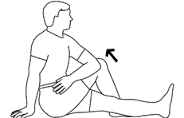
- This is a deep internal hip rotator muscle that is situated outside the buttock. Its main role is external rotation. Even though they are tiny, deep internal rotators contribute significantly to hip movement and often go unnoticed.
- Exhale as your head, neck, and shoulders remain relaxed as you bend forward at the hips and lower your head toward the ground.
- Sit on the ground with both legs straightened in front of you.
- After crossing your right leg over your left, plant your right foot firmly on the earth.
- After your body, place your right hand on the ground.
- Position your left hand on your right thigh or your left elbow on your right knee (as shown) and squeeze your right leg to the left as you rotate your trunk to the right.
- Just use your left hand to pull your right quadriceps in and to the left if the spinal twist is causing distress to your back.
Lunge With Spinal Twist

- This stretch is beneficial for those who sit for extended periods or have pain related to bad posture. It facilitates greater thoracic (mid-back) mobility and hip opening.
- Place your feet together as you stand to begin this stretching. Step forward with your left foot to create a stance that appears to be walking.
- Flex your left knee and come into a lunge position, keep your right leg straight behind you with your toes on the floor, so you feel a stretch at the front of your right thigh.
- Position your right hand on the base and turn your upper limb to the left as you straighten your left arm toward the ceiling.
- Hold for 30 seconds for 3 sets.
- Repeat on the other side.
Figure Four Stretch
- Figure Four Stretches are typically performed for the I.T. band and the piriformis and iliopsoas muscles, which are essentially your hip rotator and flexor muscles.
- To initiate this exercise you have to take a supine position with your feet flat on the base.
- Cross your right leg over your left anterior thigh.
- Lift your left leg off the ground. Gently draw your right leg towards your chest while holding it back.
- Hold for thirty seconds for three sets.
- Switch sides and repeat.
90/90 Stretch
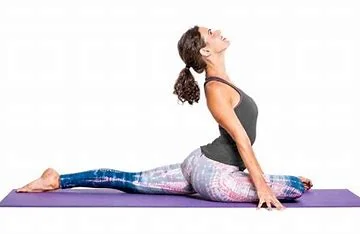
This particular stretch is a variation of the pigeon pose. It helps to work the internal and external rotation of both legs, which works the hips simultaneously. For those with extremely tight hip flexors, it is a good option. The front thigh is relaxed and firmly planted on the ground.
- To start this stretching take a Sitting position with your left knee flexed at 90 degrees in front of you, your calf vertical to your body, and the sole of your foot facing to the right.
- Keep your right foot flexed. Place your leg flat on the floor.
- Position your right knee to the right of your body and bend it so that your foot is facing backward.
- Maintain a flexed right foot. Maintain your left cheek and buttocks on the ground.
- Try to touch the right side of the face as close to the mat as possible.
- It may not be possible if you are super tight. Maintain this position for thirty seconds for 2 sets.
- Repeat this on the opposite side.
Frog Stretch
Most people cross their legs when they sit, which can cause hip tightness and back pain.
- To start this exercise come on all four limbs.
- Move your knees wider than shoulder-width apart.
- Push your foot outward and rest the inner edges of your feet flat on the base.
- Shift your buttocks back toward your heels.
- For a more comfortable stretch, proceed from your hands to your forearms.
- Hold for thirty seconds for 3 sites.
Butterfly Stretch
- With your knees bent out to the sides and your feet flat on the floor, assume a tall seated position.
- Squeeze your abs and slowly lower your body as close to your feet as you can while keeping your knees pressed into the floor. Hold onto your ankles or feet.
- Put your knees down if you are too tight to bend over.
- For three sets, hold this stretch for thirty seconds.
Side Bend Stretch
- Your back should be straight, your core should be tight, and you should be kneeling on the ground.
- Reach out and spread your right leg apart. It can’t be in front of you or behind you; it has to be perpendicular.
- Gently bend your trunk and left arm to the right side, while extending your left arm overhead and placing your right arm on your right leg.
- Face forward with your hips. Make three sets of 30 seconds to hold this stretch.
- Repeat with the other side.

Lunging Hip Flexor Stretch
- Lie down on your right knee. With your knee bent, place your left foot flat on the ground in front of you.
- Extend your right hip towards the floor as you lean forward.
- To further extend your hip flexor, contract your glutes.
- Hold for three sets of thirty seconds each.
- Reverse the sides and continue.
Knee to Chest Stretch
- You must lie on your back with both legs extended to complete this stretch.
- Maintaining your lower back pressed into the ground and your right leg straight, pull your left knee into your chest.
- For three sets, hold for thirty seconds.
- Continue with the other leg.
Lying Quad Stretch

One of the most common lower limb stretches is for the quadriceps, particularly after a strenuous cardio workout like riding or running. This stretch eliminates balance by being the exact opposite of the usual standing variation.
- You must lie on one side to complete this exercise.
- Now flex your both knees. then hold your above leg with your hand and pull it towards your buttocks.
- Hold your top foot with your hand, pulling it toward your buttocks.
- Keep your hips stable so you are not rocking back as you pull.
- Hold for thirty seconds for 3 sets.
- Switch sides and repeat.
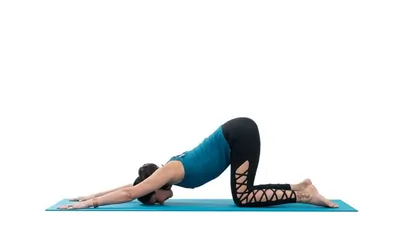
Extended Puppy Pose
- You must begin this exercise on all four limbs.
- You need to curl your toes under and extend your arms a few inches forward.
- Lift and turn your hips in the direction of your heels.
- Maintain your arms straight and engaged by pushing through your palms.
- Hold for three sets of thirty seconds.
Reclining Bound Angle Pose

- This is an ideal stretching pose for after a workout and a great way to release tension.
- Take a supine position and flex your knees.
- Now, Your knees should open up and come closer to the floor as you bring the soles of your feet together.
- Hold for thirty seconds 3 times.
Standing Quad Stretch
- You must stand with your feet together to complete this stretch.
- Flex your right knee and use your right hand to pull your right foot toward your buttocks. your knees should be together.
- If you lose your balance then take one hand support on a wall for balance.
- To extend the anterior thighs more, contract your glutes.
- Hold for thirty seconds for 3 sets.
- Repeat this on the opposite leg.
Stretching essentials
Make sure you’re stretching safely and effectively before you begin. Although you can stretch anywhere and at any time, it’s essential to use the right form. Stretching incorrectly could cause more harm than good.
To keep stretching safe, follow these tips:
- Do not consider stretching as a warmup. Warm up with low-intensity activities like walking, jogging, or biking for five to ten minutes before stretching. Warm muscles make it easier for them to stretch after a workout.
- Before starting a strenuous exercise like running or track and field activities, think about forgoing stretching. According to specific studies, stretching before an event could make people do worse. Additionally, studies have demonstrated that stretching right before an activity or game reduces hamstring strength.
- Everybody is slightly different and has varied genetics for flexibility. Concentrate on having similar flexibility from side to side instead of seeking the flexibility of a dancer or gymnast (particularly if you have a history of a prior injury). One potential risk factor for injury could be the varying degrees of flexibility on the two sides.
- You must concentrate on your main muscle groups. Stretching should be focused on the main muscle groups in your body, including your neck, shoulders, lower back, thighs, and hips. Both sides must be extended. Stretching the joints and muscles you use often will help maintain your health as you go about your everyday tasks.
- Don’t jump around. Avoid jumping and improve in a fluid motion. Stretching before a close jump raises the possibility of straining and tightening your muscles.
- Maintain your position. Breathe normally and hold each stretch for approximately thirty seconds; you may need to hold for sixty seconds in areas that cause you trouble.
- Stretching should cause tension rather than pain. If you feel stretching is painful, stop doing stretches as soon as you reach this point. modify stretches to your sport. Stretching the muscles that are used especially in your sport or game is helpful, according to some analysis. Stretch your hamstrings if you play football, for example, as you are more prone to hamstring strains.
- Maintain your stretching routine. It can take time to properly stretch. The best results, however, come from stretching frequently at least twice or three times per week. It can be beneficial to stretch for even five to ten minutes at a time. You control the danger of giving up the possible advantages if you skip stretching. For example, if you stretch and it helps you increase your range of motion, if you stop stretching, it might decrease again.
- Stretching must involve movement. You can become more flexible in particular movements by doing gentle exercises like those in yoga or Pilates. In addition, these kinds of exercises may reduce the risk of falls in senior citizens. Try doing a vigorous warm-up as well.
- A dynamic warmup is when you perform exercises at a lower intensity that are similar to those in your specific sport or physical activity. After that, you warm up by progressively picking up speed and intensity. Some people might also decide to incorporate foam rolling into their dynamic warm-up before working out.
Know when to exercise caution
You may need to modify your stretching methods if you have an injury or a chronic condition. Stretching a muscle that is already strained, for example, could make it worse. If you have any health concerns, discuss the best way to stretch with your physician or physical therapist. Additionally, keep in mind that stretching does not guarantee injury prevention. For example, stretching won’t stop an overuse injury.
FAQ
Why are stretches important for the body?
Your range of motion and flexibility will both improve with this exercise. it will help you to reduce pain and prevent muscle injury.
When is the best time to give a muscle a stretch?
When your muscles are warm, it’s ideal to stretch them.
What kind of stretching works best to improve flexibility?
It was recently announced that the quickest and most efficient way to increase passive stretching is PNF stretching.
Which kind of stretching is the most effective and safest?
The safest way to increase general flexibility is via static stretching. It is ideal to complete this during your cool-down period following a workout.
When should you avoid stretching your muscles?
Avoid stretching if you experience discomfort or tension in your muscles.
What happens if you don’t stretch correctly?
Applying too much pressure to stretch muscles causes a torn muscle. Do not cause more than your capacity to get more stretch.
References
- Tirgar, P. (2023a, December 13). Stretching exercise – Type, Health Benefits, How to do? – Mobile. Mobile Physiotherapy Clinic. https://mobilephysiotherapyclinic.in/stretching-exercise/
- CPT, A. M. W., & CPT, C. S. (2023, November 10). The 24 best stretching exercises for better Flexibility. SELF. https://www.self.com/gallery/essential-stretches-slideshow
- Millar, H. (2023, October 31). Daily stretching routines: For beginners, runners, and more. https://www.medicalnewstoday.com/articles/stretching-routine#daily-routine
- Stretches to help you get loose. (n.d.). WebMD. https://www.webmd.com/fitness-exercise/ss/slideshow-stretches-to-get-loose
- A guide to basic stretches. (2023, August 30). Mayo Clinic. https://www.mayoclinic.org/healthy-lifestyle/fitness/in-depth/stretching/art-20546848
- Freutel, N. (2019, November 13). The 5-Minute daily stretching routine. Healthline. https://www.healthline.com/health/fitness-exercise/daily-stretching-routine
- Liao, S. (2023, February 21). This quick Full-Body stretching routine will help loosen stiff muscles. Real Simple. https://www.realsimple.com/health/fitness-exercise/stretching-yoga/stretching-exercises
- Flexibility exercises for young athletes – OrthoInfo – AAOS. (n.d.). https://orthoinfo.aaos.org/en/staying-healthy/flexibility-exercises-for-young-athletes/


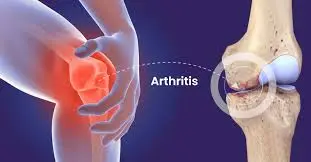
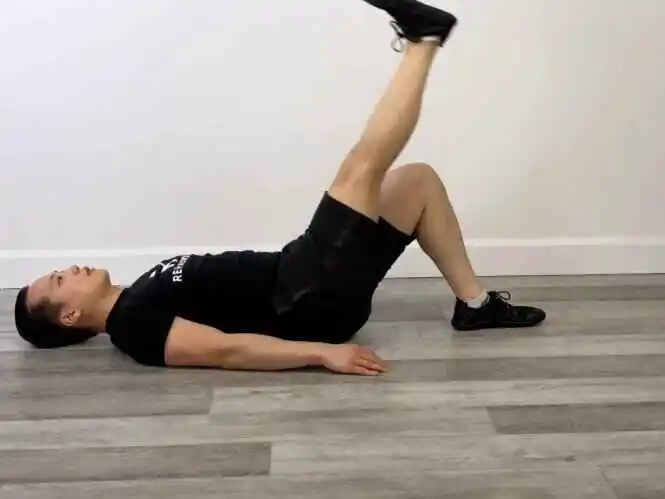




19 Comments